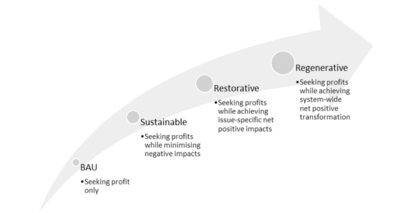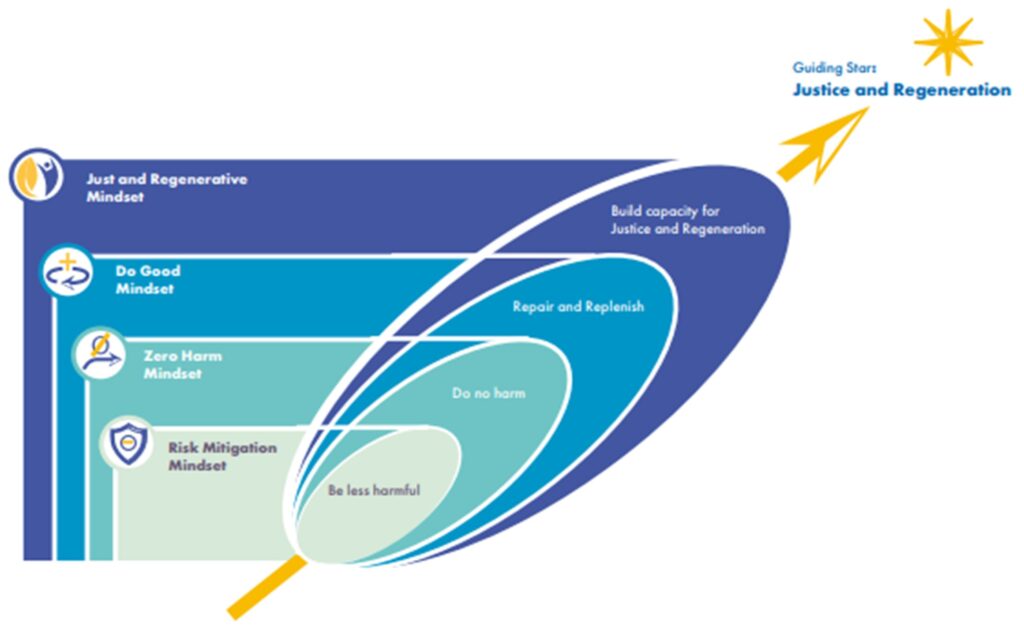Our vision at Leverage Point is to help create an environment where impact-focused companies can realize long-term success. This means we work with clients who follow regenerative principles. This is an emerging concept in business, but one that has a profound impact on how the private sector can be a force for good in our global community.
Because this is a new term for many people, we often get asked what it means to be a regenerative business. It might not be clear to everyone why a regenerative lens is different from traditional business models – or even concepts such as ESG (environmental and social governance), DE&I (diversity, equity, and inclusion), or triple-bottom line models (people, planet, profit).
These systems have more or less been adopted in the broader corporate community at some point and have provided a lot of value in rethinking how businesses view their mission and operations. However, they also come with some limitations – which is where regenerative business principles are stepping in.
Going beyond “do not harm”
The main issue is that models like ESG focus on mitigating business practices that cause harm to its broader stakeholder ecosystem. A regenerative business goes beyond mitigation, and gives back in a net positive way. The graph below from the World Economic Forum provides a visual example of the different between a company that is sustainable, and one that is regenerative.

What does this mean in practice? We can look to one of Leverage Point’s clients for a real-world example, Carbon Lock Technologies. This cleantech company is transforming organic waste into sequestered biochar, locking in CO2 that would otherwise be transmitted into the atmosphere and raising greenhouse gas emissions. Carbon Lock Tech is helping the world transform into a net-zero emissions economy. The reality of climate change is that CO2 levels are rising at a critical rate. It’s not enough to stop emitting CO2 – we need to actively remove what has been emitted in the past.
A sustainable business would work towards a “net-zero emissions” standard where no net new CO2 is being emitted. But Carbon Lock Tech has a regenerative vision: removing existing CO2 from the planetary ecosystem and bringing global CO2 levels down from current critically high levels.
Connect your business to a broader set of stakeholders
A regenerative business means actively focusing on the broader stakeholder ecosystem around it and includes social and environmental systems, climate restoration, and a commitment to human rights and justice. While this will look different for every company, the goal is to have a net positive effect on society and the environment, and actively consider that broader ecosystem as a key consideration in business decision-making.

This philosophy changes how companies define success, and how they are internally structured to meet their business objectives. For example, a commitment to equitable inclusion will help increase the scope and diversity of a company’s strategic perspectives. Creating an active dialogue with a diverse set of stakeholders can help create space for alternate viewpoints and allow everyone (regardless of their background or position) to feel like an active participant in the decision-making process. This can also be a way to identify and acknowledge barriers between stakeholders that might not be obvious to those in leadership positions because of their history or lived experience.
A regenerative business strategy is a shift in perspective and can be challenging for leaders. It shifts the focus away from profitability as the primary consideration in decision-making. Often, regenerative outcomes can be more expensive or time-consuming – but when those perspectives are placed at the forefront of a company’s mission, it’s easier to identify the decision that will better serve your stakeholder ecosystem. These decisions might lead to a reduction in net profit for your company – but the tradeoff for that is a more just society, a healthier environment, and a positive systemic transformation for your stakeholders. And you can still be a profitable, healthy company in accomplishing this.
An ever-evolving mindset
This is a learning journey for all of us – including our team at Leverage Point. That’s why our Principal Consultant Matt Schaubroeck recently completed a Practicing Regeneration course hosted by Thrivable World, which advocates for a systems-level approach to creating capacity for regenerative impact.
There’s always more to learn when it comes to regenerative business practices, and it’s something our team incorporates into all the work we do with our clients. Our core belief is that companies who incorporate regenerative principles will have greater impact, and greater long-term success, than companies who do not.
If this is something you’re interested in learning more about or have questions about how to employ a regenerative mindset in your company, reach out to our team today.
